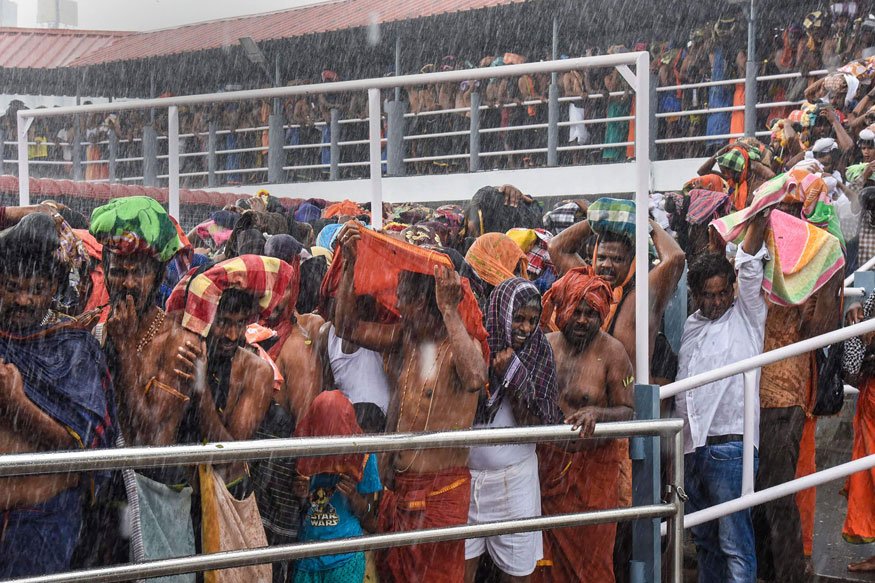This is a completely new bench and the CJI has opted not to include any judge from the previous composition; neither the ones who decided in favour of entry of women in Kerala’s Sabarimala temple nor the dissenting ones.

New Delhi: Monday onwards, the Supreme Court shall set forth on a voyage to lay down new contours of judicial interpretations of religions and religious practices. What shall stand up to these matters of faith and belief would be the rights defined under the Constitution of India.
A nine-judge bench is set to commence hearing on a clutch of cases relating to curbs on women’s entry in temples such as Sabarimala; in mosques; in Parsi temples and other places of worship.
The bench is to be headed by Chief Justice of India SA Bobde, and will include Justices R Banumathi, Ashok Bhushan, L Nageswara Rao, Mohan M Shantanagoudar, S Abdul Nazeer, R Subhash Reddy, BR Gavai and Surya Kant.
This is a completely new bench and the CJI has opted not to include any judge from the previous composition; neither the ones who decided in favour of entry of women in Kerala’s Sabarimala temple nor the dissenting ones.
The previous order in the matter pertaining to Sabarimala was passed by a five-judge bench with a 3:2 majority for referring the issues to a larger bench. The majority was of the view that the top court cannot anymore confine its judicial dictum to entry of menstruating women in Sabarimala but the need of the hour was to expand the scope of its scrutiny and look at similar restrictions in mosques and Parsi temples.
Three judges, in their order on November 14 last, cited petitions pending in the Supreme Court over women’s entry in mosques and Parsi temples. They called for an authoritative judgment on should the apex court decide what is integral to a religion and what is not since only the practices integral to a religion are the ones where courts cannot interfere.
Two judges, on the other hand, had found nothing wrong with the earlier verdict on letting women of all ages enter the Sabarimala temple. But in view of the majority decision, the subject required to be adjudged by a larger bench.
Ordinarily, a reference from a five-judge bench lies before a seven-judge bench, and not nine. However, CJI Bobde, in his wisdom and under his authority in terms of the Supreme Court rules, has constituted the nine-judge bench to consider all issues.
The 2019 order in this case may also suggest why a nine-judge bench could be directly constituted without going to seven judges first.
The majority judgment had cited inconsistencies between two Constitution Bench judgments by the Supreme Court — one by seven judges and another by five judges.
A seven-judge bench in Commissioner, Hindu Religious Endowments, Madras Vs Shri Lakshmindra Tirtha Swamiar of Shirur Mutt (Shirur Mutt case) held in 1954 that what are essential religious practices of a particular religious denomination should be left to be determined by the denomination itself.
But the subsequent view of a five-judge bench in Durgah Committee, Ajmer Vs Syed Hussain Ali & Ors, in 1962 carved out a role for the court, stating a constitutional court may exclude what it determines to be “secular practices” or “superstitious beliefs” from being parts of essential religious practices which are immune from interference.
According to the majority judgment in Sabarimala case, the 1962 judgment in Durgah Committee case was in “apparent conflict” with the previous seven-judge bench ruling in the Shirur Matt case, “requiring consideration by a larger Bench”.
This judgment also pointed out that the stipulation that a substantial question of law as to the interpretation of the Constitution should be heard by a bench of minimum five judges had come in 1950s when the strength of the Supreme Court was seven.
“In the context of the present strength of judges of the Supreme Court, it may not be inappropriate if matters involving seminal issues including the interpretation of the provisions of the Constitution touching upon the right to profess, practise and propagate its own religion, are heard by larger bench of commensurate number of judges,” the majority judgment had maintained.
It had also emphasised that in view of similar issues arising in different religions too, it is time that the Supreme Court should evolve a “judicial policy” befitting to its plenary powers to do substantial and complete justice and for an authoritative enunciation of the constitutional principles by a larger bench of “not less than seven judges”.
“The decision of a larger bench would put at rest recurring issues touching upon the rights flowing from Articles 25 and 26 (rights to profess and practice religion) of the Constitution of India… Indubitably, decision by a larger bench will also pave way to instil public confidence…That would ensure an authoritative pronouncement and also reflect the plurality of views of the judges converging into one opinion. That may also ensure consistency in approach for the posterity,” the majority judgment had held.
Now that a nine-judge bench has been constituted, it appears that the Supreme Court would want a larger bench to consider principles enunciated by not just the five-judge bench in the Durgah Committee case but also the seven-judge bench in the Shirur Matt case.
Judicial disciples shall require that only a nine-judge bench could review the seven-judge bench judgment in the Shirur Matt case, and CJI Bobde apparently wants all the issues to be settled for times to come.
Instead of first setting up a seven-judge bench and hearing the arguments for a larger bench, the CJI, on the administrative side in exercise of his powers under Order VI rule 1 of the Supreme Court Rules, 2013, decided to have nine judges consider all issues, all judgments by smaller compositions, and lay down commanding norms on religion and its practices when faced with corresponding rights of others under the Constitution.
